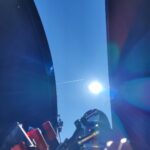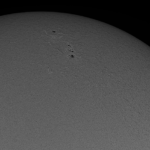Sol 13: Preparation – How to prepare a Mars mission?
Hi everyone and welcome back! In today’s report, we are going to talk about the preparation for a Martian mission.
I’m not going to talk a lot about what happened during this Sol 13 because:
1. It is Sunday, so it is not a very busy day
2. It is Sunday, so I think I deserve to rest at least this afternoon.
However, I can talk to you a bit about what happened this morning.
Even on Sunday, we still have work to do on Mars. We had to change the battery of the LOAC experiment as every day. This time, Marion and Clément heroically volunteered. They took that opportunity to install two other instruments: PurpleAir and the electric field mill. From the window of the Hab, I watched them doing their job and they did it really well. They managed to successfully install those experiments which was not easy with the gloves and the spacesuits. Now, we will start gathering data for the CNRS thank to them.
After this intense morning, at least for them two, we will finally have the lunch everybody has been waiting for since the beginning of the mission: Martian Burgers. Our Commander has already started to cook the buns and I can’t wait to taste those Martian Burgers. We will make the burger patties with rehydrated beef and add some fresh cherry tomatoes from the GreenHab. Even Gordon Ramsay has never tasted something like that. We hope it won’t become an episode of Kitchen Nightmare but we feel pretty confident.
Now let’s talk about the preparation of this Martian mission.
As some of you may already know, we’ve been preparing this mission for two years now. In fact, it was supposed to be one year, but due to Covid, we weren’t able to take off last year but we managed to delay the mission to this year.
Let’s start by the beginning of this adventure. We were chosen for this mission in December 2019. A jury composed by former crew members and professors from ISAE-SUPAERO, studied our profiles and had us take an interview to determine if we would be part of the crew and for which role.
After the selection, we started the preparation of the mission. There were, in my opinion, three main objectives.
Find sponsors and collect funds to pay for the mission. Indeed, the mission has a cost and we had to collect 20000€ to pay for everything. This part was hard because we had no experience in this domain. But we learned. We sent mails to companies, we called them and sometimes they were ready to come on this adventure with us and financially support us. Here is a list of those who accepted to support us. This list does not include those related to experiments, we will talk about them later.
-CNES is the French Space Agency. We have been working with them for outreach for younger people via the Mars Club.
-Parrot, a French drone manufacturer who also lent us two ANAFI drones which we use for my drone mapping experiment.
-The Student Association of our School which accepted to support the project via the Mars Club.
-The Fondation ISAE-SUPAERO, which is very supportive for student projects.
-Sahut-Conreur, a French company interested by the use of 3D printing for metal working applications
-Acticity, an association that acts for education of young people which is a value we strongly share
-Planète Mars, the French branch of the Mars Society. They help popularise the idea of visiting Mars in the future.
-Société générale is a large French bank partner of the Student Association of our school. They are always interested in students projects.
Find experiments to bring with us on Mars. This is a very important component of the preparation. There is no interest in going on Mars if we don’t have relevant experiments to perform there. So we did our research about experiments that would be interesting for our mission and we contacted companies and labs. It was really interesting to exchange with researchers and create procedures for the mission. Thanks to our work, we have a lot of relevant experiments to talk to you about in our « Focus on » episodes. Some labs have also accepted to financially support us to bring their experiments.
-SacLab, a ISAE-SUPAERO’s lab for which we perform the TELEOP experiment
-CNRS for which we gather data with LOAC, PurpleAir, the electric field mill and soon Mega-ARES.
-The University of Lorraine for which we perform, not without pain, the human factor experiment that includes the terrible « shapes test ».
And last objective, but not least: become a real crew. This includes:
-Get to know each other
-Learn to work together
-Learn to rely on the crew
This is really important when you are planning on going to another planet with 6 other people you don’t know yet. For that purpose, we have been meeting every week for two years. Once again, COVID complicated everything and we had to meet most of the times on Zoom. Despite that, I think we still managed to create a team spirit and I think that now we are all very good friends!
This preparation was like a marathon, you have to stay focused during two years and never lose your motivation. The second year, after the rescheduling, was the worst. It was hard to go back on working on a mission that was already prepared. On top of that, the borders between Europe and the USA were still closed so we were starting to work again towards a mission we still didn’t know if we could do. Yet we persevered, and despite the setbacks we’ve made it all the way there on Mars, and in the end that means all the work was worth it. Sure, we’ve all changed a little after a year of delay, either from our experiences of work and studies, or simply in our outlook of what this mission means to us, but the joy of getting to work on a mission we worked so hard for is still the very same.








You must be logged in to post a comment.